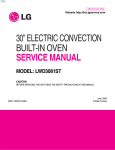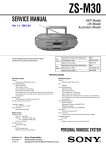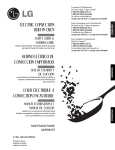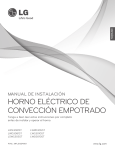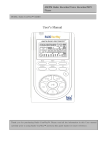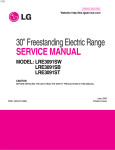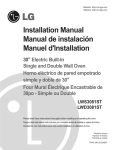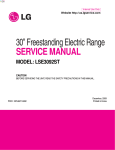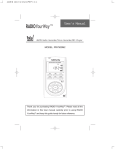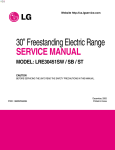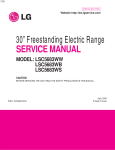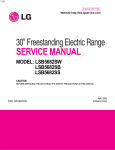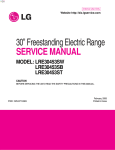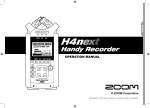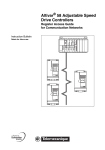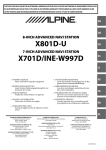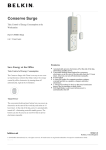Download 30” ELECTRIC CONVECTION BUILT
Transcript
삼 정 흥 판 Internal Use Only Website http://biz.lgservice.com 30” ELECTRIC CONVECTION BUILT-IN OVEN SERVICE MANUAL MODEL: LWS3081ST CAUTION BEFORE SERVICING THE UNIT, READ THE SAFETY PRECAUTIONS IN THIS MANUAL. August, 2008 Printed in Korea P/NO : MFL37118305 1 FORWARD This LG Service Manual, “30” Electric Built-in Oven”, provides the technician with information on the operation and service of the Electric Built-in Oven. It is to be used as a training Service Manual. For specific information on the model being serviced, refer to the “Owner’s Manual” or “Tech Sheet” provided with the electric oven. SAFETY PRECAUTIONS • Repairs of the appliance should be carried out by a licensed technician only. Incorrect repairs may result in dangerous situations. If you need repairs, contact an LG Service Center or your dealer. • If the power cord is defective, it must be replaced by a qualified service agent with a UL listed range cord. • Electrical leads and cables should not be allowed to touch the oven. • Rating plate is located on the bracket below the control panel. • The power supply of the appliance should be turned off when it is being repaired. WARNING • DISCONNECT power supply cord from the outlet before servicing. • Replace all panels and parts before operating. • RECONNECT all grounding devices. - Failure to do so can result in severe personal injury, death or electrical shock. • DO NOT Touch when the oven operates. - The interior parts will be very hot. LG Electronics assumes no responsibility for any repairs made on our products by anyone other than Authorized Service Technicians. TABLE OF CONTENTS (PAGE) GENERAL- - - - - - - - - - - - - - - - - - - - - - - - - - - - - - - - - - - - - - - - - - - - - - - - - - - - - - - - - - - - - - - - - - - - - - - - - - - - - - - - - - - - - - - - - - - - 1-1 ~ 1-6 • Read all instructions before use - - - - - - - - - - - - - - - - - - - - - - - - - - - - - - - - - - - - - - - - - - - - - - - - - - - - - - - - - - - - - - - - - - - - - - - - - - - - - - - - - 1-1 ~ 1-4 • Model & Serial number label and tech sheet locations - - - - - - - - - - - - - - - - - - - - - - - - - - - - - - - - - - - - - - - - - - - - - - - - - - - - - - - - - - - 1-5 • Specifications - - - - - - - - - - - - - - - - - - - - - - - - - - - - - - - - - - - - - - - - - - - - - - - - - - - - - - - - - - - - - - - - - - - - - - - - - - - - - - - - - - - - - - - - - - - - - - - - - - - - - - - - - - - - - - - - - - 1-6 USING YOUR OVEN - - - - - - - - - - - - - - - - - - - - - - - - - - - - - - - - - - - - - - - - - - - - - - - - - - - - - - - - - - - - - - - - - - - - - - - - - - - - 2-1 ~ 2-5 • General information - - - - - - - - - - - - - - - - - - - - - - - - - - - - - - - - - - - - - - - - - - - - - - - - - - - - - - - - - - - - - - - - - - - - - - - - - - - - - - - - - - - - - - - - - - - - - - - - - - - - - - - - - 2-1 • Control panel feature - - - - - - - - - - - - - - - - - - - - - - - - - - - - - - - - - - - - - - - - - - - - - - - - - - - - - - - - - - - - - - - - - - - - - - - - - - - - - - - - - - - - - - - - - - - - - - - - 2-2 ~ 2-5 - Setting the initial control - Start, clear/off - Oven light - Timer - Control lockout - Set up: 8 different category 1) Language selection 2) Temperature selection unit 3) Display brightness 4) Sound volume Loud/Normal/Mute 5) Convection auto conversion 6) Temperature adjustment 7) Clock time 8) Reset - Bake - Timed cook, Delayed timed cook - Broil - Roast - Convection bake - Crisp convection - Convection roast - Recipe bank - Proof/Warm - Healthier roast - My menu - Option - Self clean DISASSEMBLY INSTRUCTIONS - - - - - - - - - - - - - - - - - - - - - - - - - - - - - - - - - - - - - - - - - - - - - - - - - - - - - - - - - - 3-1 ~ 3-3 • Component Locations- - - - - - - - - - - - - - - - - - - - - - - - - - - - - - - - - - - - - - - - - - - - - - - - - - - - - - - - - - - - - - - - - - - - - - - - - - - - - - - - - - - - - - - - 3-1 DISASSEMBLY INSTRUCTIONS - - - - - - - - - - - - - - - - - - - - - - - - - - - - - - - - - - - - - - - - - - - - - - - - - - - - - - - - - - - 3-2 ~ 3-3 • Replacing the control panel and related components - - - - - - - - - - - - - - - - - - - - - - - - - - - - - - - - - - - - - - - - - - - - - - - - - - - - - - - - - 3-2~3-3 - Removing the Low Voltage Transformer (controller)- - - - - - - - - - - - - - - - - - - - - - - - - - - - - - - - - - - - - - - - - - - - - - - - - - - - - - - - - - - - - - 3-2 - Removing the Relay PCB - - - - - - - - - - - - - - - - - - - - - - - - - - - - - - - - - - - - - - - - - - - - - - - - - - - - - - - - - - - - - - - - - - - - - - - - - - - - - - - - - - - - - - - - - - - - - - - - - 3-3 - Removing the door lock assembly- - - - - - - - - - - - - - - - - - - - - - - - - - - - - - - - - - - - - - - - - - - - - - - - - - - - - - - - - - - - - - - - - - - - - - - - - - - - - - - - - - - - - - 3-3 - Removing the Low Voltage Transformer (halogen lamp) - - - - - - - - - - - - - - - - - - - - - - - - - - - - - - - - - - - - - - - - - - - - - - - - - - - - - - - - 3-3 - Removing the Serge filter - - - - - - - - - - - - - - - - - - - - - - - - - - - - - - - - - - - - - - - - - - - - - - - - - - - - - - - - - - - - - - - - - - - - - - - - - - - - - - - - - - - - - - - - - - - - - - - - - 3-3 DISASSEMBLY INSTRUCTIONS- - - - - - - - - - - - - - - - - - - - - - - - - - - - - - - - - - - - - - - - - - - - - - - - - - - - - - - - - - - - 3-4 ~ 3-5 • Replacing oven cavity components - - - - - - - - - - - - - - - - - - - - - - - - - - - - - - - - - - - - - - - - - - - - - - - - - - - - - - - - - - - - - - - - - - - - - - - - - - - - - - - 3-4 ~ 3-5 - Removing the Broil element - - - - - - - - - - - - - - - - - - - - - - - - - - - - - - - - - - - - - - - - - - - - - - - - - - - - - - - - - - - - - - - - - - - - - - - - - - - - - - - - - - - - - - - - - - - - - - 3-4 - Removing the Convection element - - - - - - - - - - - - - - - - - - - - - - - - - - - - - - - - - - - - - - - - - - - - - - - - - - - - - - - - - - - - - - - - - - - - - - - - - - - - - - - - - - - - - 3-4 - Removing the Blade fan - - - - - - - - - - - - - - - - - - - - - - - - - - - - - - - - - - - - - - - - - - - - - - - - - - - - - - - - - - - - - - - - - - - - - - - - - - - - - - - - - - - - - - - - - - - - - - - - - - - 3-5 - Removing the Halogen lamp & socket assembly - - - - - - - - - - - - - - - - - - - - - - - - - - - - - - - - - - - - - - - - - - - - - - - - - - - - - - - - - - - - - - - - - - 3-5 • Replacing other electrical components.- - - - - - - - - - - - - - - - - - - - - - - - - - - - - - - - - - - - - - - - - - - - - - - - - - - - - - - - - - - - - - - - - - - - - - - - - - 3-6 ~ 3-9 - Removing the Vent motor - - - - - - - - - - - - - - - - - - - - - - - - - - - - - - - - - - - - - - - - - - - - - - - - - - - - - - - - - - - - - - - - - - - - - - - - - - - - - - - - - - - - - - - - - - - - - - - - - 3-6 - Removing the Thermal limiter - - - - - - - - - - - - - - - - - - - - - - - - - - - - - - - - - - - - - - - - - - - - - - - - - - - - - - - - - - - - - - - - - - - - - - - - - - - - - - - - - - - - - - - - - - - 3-7 - Removing the Door switch - - - - - - - - - - - - - - - - - - - - - - - - - - - - - - - - - - - - - - - - - - - - - - - - - - - - - - - - - - - - - - - - - - - - - - - - - - - - - - - - - - - - - - - - - - - - - - - 3-7 - Removing the Thermal limiter (Double Line Break) - - - - - - - - - - - - - - - - - - - - - - - - - - - - - - - - - - - - - - - - - - - - - - - - - - - - - - - - - - - - - - - 3-8 - Removing the Convection motor assembly - - - - - - - - - - - - - - - - - - - - - - - - - - - - - - - - - - - - - - - - - - - - - - - - - - - - - - - - - - - - - - - - - - - - - - - - - 3-8 - Removing the Hidden bake element - - - - - - - - - - - - - - - - - - - - - - - - - - - - - - - - - - - - - - - - - - - - - - - - - - - - - - - - - - - - - - - - - - - - - - - - - - - 3-8 ~ 3-9 DISASSEMBLY INSTRUCTIONS - - - - - - - - - - - - - - - - - - - - - - - - - - - - - - - - - - - - - - - - - - - - - - - - - - - - - - - - 3-10 ~ 3-13 • Removing & Reinstalling the lift-off oven door - - - - - - - - - - - - - - - - - - - - - - - - - - - - - - - - - - - - - - - - - - - - - - - - - - - - - - - - - - - - - - - - - - - - - - - 3-10 • Removing the oven door handle & glass- - - - - - - - - - - - - - - - - - - - - - - - - - - - - - - - - - - - - - - - - - - - - - - - - - - - - - - - - - - - - - - - - - - - - 3-11 ~ 3-12 • Removing the oven door gasket- - - - - - - - - - - - - - - - - - - - - - - - - - - - - - - - - - - - - - - - - - - - - - - - - - - - - - - - - - - - - - - - - - - - - - - - - - - - - - - - - - - - - - - - - - 3-13 COMPONENT TEST - - - - - - - - - - - - - - - - - - - - - - - - - - - - - - - - - - - - - - - - - - - - - - - - - - - - - - - - - - - - - - - - - - - - - - - - - - - - - 4-1 ~ 4-4 • Convection motor- - - - - - - - - - - - - - - - - - - - - - - - - - - - - - - - - - - - - - - - - - - - - - - - - - - - - - - - - - - - - - - - - - - - - - - - - - - - - - - - - - - - - - - - - - - - - - - - - - - - - - - - - - - - - 4-1 • Door locking motor- - - - - - - - - - - - - - - - - - - - - - - - - - - - - - - - - - - - - - - - - - - - - - - - - - - - - - - - - - - - - - - - - - - - - - - - - - - - - - - - - - - - - - - - - - - - - - - - - - - - - - - - - - - 4-2 • Door locking micro switch - - - - - - - - - - - - - - - - - - - - - - - - - - - - - - - - - - - - - - - - - - - - - - - - - - - - - - - - - - - - - - - - - - - - - - - - - - - - - - - - - - - - - - - - - - - - - - - - - 4-2 • Low Voltage Transformer - Controller - - - - - - - - - - - - - - - - - - - - - - - - - - - - - - - - - - - - - - - - - - - - - - - - - - - - - - - - - - - - - - - - - - - - - - - - - - - - - - - - 4-2 • Low Voltage Transformer - Halogen lamp - - - - - - - - - - - - - - - - - - - - - - - - - - - - - - - - - - - - - - - - - - - - - - - - - - - - - - - - - - - - - - - - - - - - - - - - - - 4-2 • Oven Thermistor - - - - - - - - - - - - - - - - - - - - - - - - - - - - - - - - - - - - - - - - - - - - - - - - - - - - - - - - - - - - - - - - - - - - - - - - - - - - - - - - - - - - - - - - - - - - - - - - - - - - - - - - - - - - - - 4-3 • Door switch - - - - - - - - - - - - - - - - - - - - - - - - - - - - - - - - - - - - - - - - - - - - - - - - - - - - - - - - - - - - - - - - - - - - - - - - - - - - - - - - - - - - - - - - - - - - - - - - - - - - - - - - - - - - - - - - - - - - - 4-3 • Oven lamp - - - - - - - - - - - - - - - - - - - - - - - - - - - - - - - - - - - - - - - - - - - - - - - - - - - - - - - - - - - - - - - - - - - - - - - - - - - - - - - - - - - - - - - - - - - - - - - - - - - - - - - - - - - - - - - - - - - - - - 4-3 • Broil Element - - - - - - - - - - - - - - - - - - - - - - - - - - - - - - - - - - - - - - - - - - - - - - - - - - - - - - - - - - - - - - - - - - - - - - - - - - - - - - - - - - - - - - - - - - - - - - - - - - - - - - - - - - - - - - - - - - - 4-4 • Bake Element - - - - - - - - - - - - - - - - - - - - - - - - - - - - - - - - - - - - - - - - - - - - - - - - - - - - - - - - - - - - - - - - - - - - - - - - - - - - - - - - - - - - - - - - - - - - - - - - - - - - - - - - - - - - - - - - - - 4-4 • Convection element - - - - - - - - - - - - - - - - - - - - - - - - - - - - - - - - - - - - - - - - - - - - - - - - - - - - - - - - - - - - - - - - - - - - - - - - - - - - - - - - - - - - - - - - - - - - - - - - - - - - - - - - - 4-4 • Vent motor - - - - - - - - - - - - - - - - - - - - - - - - - - - - - - - - - - - - - - - - - - - - - - - - - - - - - - - - - - - - - - - - - - - - - - - - - - - - - - - - - - - - - - - - - - - - - - - - - - - - - - - - - - - - - - - - - - - - - - 4-4 DIAGNOSIS THROUGH SCHEMATIC - - - - - - - - - - - - - - - - - - - - - - - - - - - - - - - - - - - - - - - - - - - - - - - - - - - - - - - - - - - 5-1 HOW TO ENTER THE TEST MODE - - - - - - - - - - - - - - - - - - - - - - - - - - - - - - - - - - - - - - - - - - - - - - - - - - - - - - - - - - - - - - 5-2 SAFETY CAUTION & ERROR CODE SUMMARY - - - - - - - - - - - - - - - - - - - - - - - - - - - - - - - - - - - - - - - - - - - 5-3 CHECKING FLOW CHART BY FAILURE MODE - - - - - - - - - - - - - - - - - - - - - - - - - - - - - - - - - - 5-3 ~ 5-18 • Dead - - - - - - - - - - - - - - - - - - - - - - - - - - - - - - - - - - - - - - - - - - - - - - - - - - - - - - - - - - - - - - - - - - - - - - - - - - - - - - - - - - - - - - - - - - - - - - - - - - - - - - - - - - - - - - - - - - - - - - - 5-4 ~ 5-8 • Oven does not heat (including F-9 error) - - - - - - - - - - - - - - - - - - - - - - - - - - - - - - - - - - - - - - - - - - - - - - - - - - - - - - - - - - - - - - - - - - - - - 5-9 ~ 5-12 • Not operating Key (including F-3 error)- - - - - - - - - - - - - - - - - - - - - - - - - - - - - - - - - - - - - - - - - - - - - - - - - - - - - - - - - - - - - - - - - - - - - - - - - - - - - - - - 5-13 • Lock system failure (including F-10 error)- - - - - - - - - - - - - - - - - - - - - - - - - - - - - - - - - - - - - - - - - - - - - - - - - - - - - - - - - - - - - - - - - - - 5-14 ~ 5-15 • Oven Thermistor failed (including F-1, F-2 error)- - - - - - - - - - - - - - - - - - - - - - - - - - - - - - - - - - - - - - - - - - - - - - - - - - - - - - - - - - - - - - - - - - - 5-16 • Oven too hot (including F-6 error)- - - - - - - - - - - - - - - - - - - - - - - - - - - - - - - - - - - - - - - - - - - - - - - - - - - - - - - - - - - - - - - - - - - - - - - - - - - - - - - - - - - - - - - 5-17 • Communication error → F-10 error - - - - - - - - - - - - - - - - - - - - - - - - - - - - - - - - - - - - - - - - - - - - - - - - - - - - - - - - - - - - - - - - - - - - - - - - - - - - - - - - - - - - - 5-18 SCHEMATIC DIAGRAM - - - - - - - - - - - - - - - - - - - - - - - - - - - - - - - - - - - - - - - - - - - - - - - - - - - - - - - - - - - - - - - - - - - - - - - - - - - - - - - 6-1 • Strip circuits - - - - - - - - - - - - - - - - - - - - - - - - - - - - - - - - - - - - - - - - - - - - - - - - - - - - - - - - - - - - - - - - - - - - - - - - - - - - - - - - - - - - - - - - - - 6-2 ~ 6-5 EXPLODED VIEW - - - - - - - - - - - - - - - - - - - - - - - - - - - - - - - - - - - - - - - - - - - - - - - - - - - - - - - - - - - - - - - - - - - - - - - - - - - - - - - 7-1 ~ 7-6 REPLACEMENT PARTS LIST - - - - - - - - - - - - - - - - - - - - - - - - - - - - - - - - - - - - - - - - - - - - - - - - - - - - - - - - - - - - - - 8-1 ~ 8-3 GENERAL READ ALL INSTRUCTIONS BEFORE USE Read and follow all instructions before using your oven to prevent the risk of fire, electric shock, injury to person, or damage when using the range. This guide don’t cover all possible conditions that may occur. For further assistance contact your service agent or manufacturer. This is the safety alert symbol. This symbol alerts you to potential hazards that can kill or hunt you and others. All safety messages will follow the safety alert symbol and either the word “WARNING” or “CAUTION”. These word means : WARNING This symbol will alert you to hazards or unsafe practices which could cause serious bodily harm or death. CAUTION This symbol will alert you to hazards or unsafe practices which could cause bodily injury or property damage. WARNING • NEVER use your appliance for warming or heating the room. • DO NOT use water on grease fires. - Turn off the oven to avoid spreading the flames. Smother the fire by closing the oven door or use dry chemical, baking soda, or foam-type extinguishers. • Use only dry pot holders. - Moist or damp pot holders on hot surfaces may result in burns from steam. Do not let the pot holder touch hot heating elements. Do not use a towel or other bulky cloth. • Storage in or on appliance. - Flammable materials should not be stored in an oven or near surface elements. • Wear proper apparel. - Loose-fitting or hanging garments should never be worn while using the appliance. • DO NOT place aluminum foil directly on the oven bottom. • Children should be kept away from the oven. - Accessible parts may become hot when the broil is use. • DISCONNECT power supply cord from the outlet before servicing. • Replace all panels and parts before operating. • RECONNECT all grounding devices. - Failure to do so can result in severe personal injury, death or electrical shock. • DO NOT Touch when the oven operates. - The interior parts will be very hot. • ELECTRIC SHOCK HAZARD - Unit must be disconnected from electrical outlet when making repairs, replacements, adjustments. Replace all panels before operating oven. Failure to do so can result in death or electrical shock. CAUTION • DO NOT leave children alone. - Children should not be left alone or unattended in area where appliance is in use. - Children should never be allowed to sit or stand on any part of the appliance. • DO NOT leave small children unattended near the appliance. - During the self-cleaning cycle, the outside of the oven can become very hot to touch. • Be careful when you work on the electric oven handling the sheet metal part. - Sharp edge may be present and you can cut yourself. • Be careful not to bend the fan blade. • The door is very heavy. Be careful when removing and lifting door. Do not lift the door by the handle. 1-1 GENERAL READ ALL INSTRUCTIONS BEFORE USE SAFETY PRECAUTIONS • Be certain all packing materials are removed from the appliance before operating. Keep plastics, clothes, and paper away from parts of the appliance that may become hot. • DO NOT force the door open. This can damage the automatic door locking system. Use care when opening the oven door after the self-cleaning cycle. Stand to the side of the oven when opening the door to allow hot air or steam to escape. The oven may still be VERY HOT. • DO NOT use a steel-wool pad. It will SCRATCH the surface. • DO NOT use harsh etching, abrasive cleaners or sharp metal scrapers to clean the oven door glass since they can scratch the surface. It may result in shattering of the glass. • Be careful when removing and lifting the door. • DO NOT lift the door by the handle. The door is very heavy. • DO NOT step or sit on oven door. Be sure to follow proper installation instructions. • Be certain your appliance is properly installed and grounded by a qualified technician. • Do not repair or replace any part of the appliance unless specifically recommended in the manual. • All other servicing should be referred to a qualified technician. • Always disconnect power to appliance before servicing by unplugging, removing the fuse or switching off the circuit breaker. • DO NOT TOUCH HEATING ELEMENTS OR INTERIOR SURFACES OF OVEN. Heating elements may be hot even though they are dark in color. Interior surfaces of an oven become hot enough to cause burns. During and after use, do not touch or let clothing or other flammable materials contact heating elements or interior surfaces of oven until they have had sufficient time to cool. Other surfaces of the appliance may become hot enough to cause burns. Among these surfaces are oven vent openings and surfaces near these openings, oven doors, and windows of oven doors. • Use Care When Opening Door. Let hot air or steam escape before you remove or replace food in the oven • Do Not Heat Unopened Food Containers. Build-up of pressure may cause container to burst and result in injury. • Keep Oven Vent Ducts Unobstructed. The oven vent could become hot during oven use. Never block this vent and never Metal bottom place plastic or heattrim (Vent) sensitive items on or near the vent. NOTE: For proper operation vent trim must be installed. ELECTRICAL SAFETY • Protective Liners. Do not use aluminum foil or any other material to line the oven bottoms. Improper installation of these liners may result in a risk of electric shock or fire. • Do Not allow aluminum foil or meat probe to contact heating elements. WARNING Aluminum foil • DO NOT place aluminum foil directly on the oven bottom. 1-2 GENERAL READ ALL INSTRUCTIONS BEFORE USE • Before replacing your oven light bulb, switch off the electrical power to the oven at the main fuse or circuit breaker panel. Failure to do so can result in severe personal injury, death, or electrical shock. • DO NOT line the oven walls, racks, bottom, or any other part of the oven with aluminum foil or any other material. Doing so will disrupt heat distribution, produce poor baking results and cause permanent damage to the oven interior (aluminum foil will melt to the interior surface of the oven.) CHILD SAFETY WARNING • Children should be kept away from the oven. • Accessory parts will become hot when the broiler is in use. CAUTION SAFETY DURING USE • Children should not be left alone or unattended in area where appliance is in use. Children should never be allowed to sit or stand on any part of the appliance. • Oven Racks. Always place oven racks in desired position while oven is cool. • Always use pot holders or oven mitts when removing food from the oven. You can be burned because cookware and plates will be hot. • Use caution with the TIMED BAKE or DELAYED TIMED BAKE features. Use the automatic timer when cooking cured or frozen meats and most fruits and vegetables. Foods that can easily spoil, such as milk, eggs, fish, meat or poultry, should be chilled in the refrigerator first. Even when chilled, they should not stand in the oven for more than 1 hour before cooking begins, and should be removed promptly when cooking is completed. Eating spoiled food can result in sickness from food poisoning. • Should an oven fire occur, leave the oven door closed and turn the oven off. If the fire continues, throw baking soda on the fire or use a fire extinguisher. • DO NOT put water or flour on the fire. Flour may be explosive and water can cause a grease fire to spread and cause personal injury. • DO NOT use the broiler pan without the grid. DO NOT cover the grid with aluminum foil. CAUTION • DO NOT leave small children unattended near the appliance. During the self-cleaning cycle, the outside of the oven can become very hot to the touch. 1-3 GENERAL READ ALL INSTRUCTIONS BEFORE USE SAFETY WHEN CLEANING • Important Instruction. In the event the self clean error code F is displayed, and error melody sounds, the oven is malfunctioning in the self clean mode. Switch off the electrical power to the main fuse or breaker and have serviced by a qualified technician. • Make sure oven lights are cool before cleaning. • DO NOT block the oven vent during operation. This can damage the electric parts of the oven. Air must be able to move freely. The metal bottom trim (vent) should be properly assembled on the front bottom of oven before installing the oven door. • Do Not Clean Door Gasket. The door gasket is essential for a good seal. Care should be taken not to rub, damage, or move the gasket. • Do Not Use Oven Cleaners. No commercial oven cleaner or oven liner protective coating of any kind should be used in or around any part of the oven. • Before self cleaning the oven. Remove broiler pan, all oven racks, meat probe and any other utensils from the oven cavity. • Never keep pet birds in the kitchen. The health of birds is extremely sensitive to the fumes released during an oven self-clean cycle. Fumes may be harmful or fatal to birds. Move birds to well-ventilated room. Metal bottom trim (Vent) 1-4 GENERAL MODEL & SERIAL NUMBER LABEL AND TECH SHEET LOCATION The Model/Serial Number label and Tech Sheet locations are shown below. Model & Serial Number Location Tech Sheet Location 1-5 GENERAL SPECIFICATIONS Product Specification List No Items Specifications Remarks 1 Model name LWS3081ST 2 Rating power source 240 V~ 60 Hz 3 Heat source Sheath heater & Carbon heater 4 Max power 4.1 KW 5 Max input current 17.3 A 6 Rating power consumption Bake 2,500W / 10.4A & Rating input current Broil 4,000W / 16.7A Convection 2,500W /10.4A Lamp 12V/10W/0.8A Front ceiling area Lamp (12V/10W/0.8A×2) Left & right sides Cooling motor 120V/41W/0.34A Convection motor 120V/42W/0.65A Locking motor 120V/3.5W/0.03A Built-in Single wall oven North American market Single phase & 4-wires 120/208V : 3.0 KW 7 Efficiency Higher than 80% 8 Control style Touch screen, glass touch & Micom 9 Display White LCD Liquid Crystal Display 10 Power control range 170~550˚F (77~288˚C) At bake mode 11 Capacity (Overall, W×H×D) 4.7 cu.ft (622×449×474 ) 24 1/2×17 11/16×18 5/8 12 Capacity (Usable) 3.2 cu.ft (601×345×436 ) 23 5/8×13 9/16×17 3/16 13 Cut out size (W×H×D) 724×735×596 28 1/2×28 15/16×23 1/2 14 Unit Dimension 755×745×619 29 3/4×29 5/16×24 3/8 15 Net Weight 71 Kg 154 lbs 16 Packing size 838×864×762 33×34×30 17 Packing weight 81 Kg 187 lbs 18 Stack height 3 levels 1-6 USING YOUR OVEN GENERAL INFORMATION Cooking Guide Refer to the owners manual for recommendations of times and temperatures. Times, rack position, and temperatures may vary depending on conditions and food type. For best results, always check food at minimum time. When roasting, choose rack position based on size of food item. Rating Label Model numbers are recorded on the rating label. Rating label is located on the lower left bottom area of the controller. It can be seen by opening the door. Before ordering parts, write down the correct model and serial number from rating label. This avoids incorrect shipments and delays. Please refer to parts reference material when ordering replacement parts. Functional Operation Bake Mode Top and hidden bottom elements operate during bake. Bake can be used to cook foods which are normally baked. Oven must be preheated. Convection fan and heater operates during the Preheat cycle of Bake mode. Broil Mode Top element operates during broil. Broil can be used to cook foods which are normally broiled. Preheating is not required when using broil. All foods should be turned at least once except fish, which does not need to be turned. Convection Bake / Roast Mode Upper element, lower element, Rear element and fan operate during convection bake. Convection bake should be used for cooking casseroles and roasting meats. Oven should be preheated for best results when using convection bake. Pans do not need to be staggered. Cooks approximately 25% quicker than bake. Broil element Convection element Bake element 2-1 USING YOUR OVEN CONTROL PANEL FEATURES READ THE INSTRUCTIONS CAREFULLY BEFORE USING THE OVEN. For satisfactory use of your oven, become familiar with the various features and functions of the oven as described below. 1 5 3 4 1. OVEN LIGHT: Use to turn the oven lights on and off. 2. START: Use to start all oven features. Activate the CONTROL LOCK for 4 seconds holding. 3. TIMER ON/OFF: Use to set or cancel the timer. 4. CLEAR/OFF: Use to stop cooking or cancel the setting of the oven. 5. Touch Screen: Show the time of day, main menu, and oven temperature; whether the oven is the bake, broil or selfcleaning mode; and the times set for the timer or automatic oven operations. The display panel will go into a "sleep" mode if no activity. Touch the display once to activate and again to make your selection. 6 7 8 12 13 10 6. Bake: Use to select the normal bake mode. 7. Broil: Use to set the variable broil mode. 8. Roast: Use to select the normal roast mode. 9. Conv. Bake: Use to select the convection bake mode. 10. Crisp Conv.: Use to select the crisp convection mode. 11. Conv. Roast: Use to select the convection roast mode. 12. Recipe Bank: Use to recall the recipe category of gourmet food. 13. Proof/Warm: Use to proof bread / Use to hold food warm. 14. Healthier Roast: Use to select the healthier roast mode. 15. My Menu: Use to save or recall the favorite 10 cook mode. 16. Set up: Use to change the special settings. 17. Self Clean: Use to select the self-cleaning cycle. 15 NOTE: • Press CLEAR/OFF pad. Allow the oven to cool for one hour. Put back into operation. • If the function error code repeats, disconnect the power to the oven and call for service. • If the oven was set for a timed oven operation and a power failure occurred, the clock and all programmed functions must be reset. • The time of day will flash and PF will appear in the display when there has been a power failure. 00:00:00 11:35 am Cook & Warm 9 2 14 11 16 17 2-2 USING YOUR OVEN 3) Hour and Min setting 1. SETTING THE INITIAL CONTROL 1) LG logo display 8 seconds. - Initial display (Power Failure or Reset) First, Select Language, and set clock time, and then the oven can be used. If power failure occurs, the oven will remember your language selection however you will still need to set the time of day. TIMER TIMER NUMERIC (Set the desired time-hour and min) TIMER 4) When the set time has elapsed, “Timer End” is displayed. Timer alarm melody will sound every 15 seconds until TIMER is pressed. Press timer key in order to cancel running timer or clear timer end alarm. The time less than 1hour is displayed in min and sec on timer operation. 5. CONTROL LOCKOUT 1) The START key controls the Control Lock feature. The Control Lock feature automatically locks most oven controls from being turned ON. It does not disable the timer and the interior oven light. The Control Lock feature will cancel the cooking mode and will lock the oven controls at any time when you activate this feature. 2) Key Input Process : START (for 4 seconds) 2) Key Function, General Usage While selecting any function, an appropriate key input sequence must be followed. In case of an inappropriate input sequence the key error beeps sound. Numeric key are used while entering data (temperature and time) for cooking. 2. START, CLEAR/OFF Lock melody will sound. 1) START key to start oven 2) CLEAR/OFF key to cancel a program during cooking or erase during programming. 3) To unlock the control, press START (for 4 seconds) Unlock melody will sound. 3. OVEN LIGHT 6. SET UP (8 DIFFERENT CATEGORIES) 1) Requirement: The Oven Light is used to turn on or off the oven light. 2) Key Input Process: Oven Light-ON/OFF toggle operation. If the Oven Light is on by pressing oven light key, the light is on even if the door is closed. Oven light key can be operated while door opens. 3) Exception: Oven light will not operate during a self clean cycle. Once self clean is complete the oven light will not operate until oven cools down. 1) Language Selection 1. Requirement: The scroll display can be shown either in English/Spanish/French. 2. Key Input Process Set Up Select language 3. CLEAR to reject the change. 2) Temperature Selection unit 1. Requirement: The oven control can be programmed to display temperatures in Fahrenheit or Centigrade. The oven has been preset at the factory to display in Fahrenheit. 2. Key Input Process 4. TIMER 1) Requirement: The timer works like an alarm clock that will continuously beep until turned off. The oven can fully operate during the use of the timer. Set Up Select Temp.Unit - Setting Limit : 11Hour : 59Min 3. CLEAR to reject the change. 2) Min and Sec Setting; TIMER NUMERIC (Set the desired time-min and sec) OK TIMER 2-3 OK USING YOUR OVEN 3) Display brightness 1. Requirement: LCD Display Brightness adjustment 2. Key Input Process Set Up Select Brightness 7) Clock Time 1. Requirement: The clock key is used to set the clock in idle mode. The clock can be set to 12 or 24 hour format. am and pm can be set in 12 hours.When the oven is initially plugged in, or when the power supply to the oven is interrupted, the clock time is saved in ROM. 2. Key Input Process OK 3. CLEAR to reject the change. 4) Sound Volume Loud/Normal/Mute 1. Requirement: When want to reduce or increase the volume. 2. Key Input Process Set Up Select Volume Set Up Select hours set clock time select am, pm OK OK 3. CLEAR to cancel the clock setting. 8) Reset 1. Requirement: Setting Value will be default value. 2. Key Input Process 3. CLEAR to reject the change. 4. Exception : Error Alarm, Preheat Alarm, Timer End Alarm – If Mute, Normal Beep Sounds. 5) Convection Auto Conversion 1. Requirement: When using convection, Auto conversion will automatically convert an entered regular baking temperatures to convection baking temperatures. 2. Key Input Process Set Up Select Yes, No OK 3. CLEAR to reject the change. 7. BAKE Set Up Select mode OK BAKE 3. CLEAR to reject the change. 6) Temperature Adjustment 1. To change the oven temperature during use follow the steps below. BAKE BROIL 2. Key Input Process Adjust Temperature START 8. TIMED COOK, DELAYED TIMED COOK Fahrenheit : (-)35 ~ (+)35 Centigrade : (-)19 ~ (+)19 Set Up Desired Temperature START OK Desired Temperature START Desired Temperature START Cook & warm 3. CLEAR to reject the change. * Note: This adjustment is available for Bake, Roast, Convection Bake, Roast, Crisp Conv. Healthier Roast. Temperature Adjustment can be confirmed by measuring real Oven Cavity Temperature. START TIME Desired start time START Cook & warm 2-4 USING YOUR OVEN 9. BROIL 16. HEALTHIER ROAST Healthier Roast Desired Broil Full / Center Broil Desired Temp High / Med / Low Desired Temperature START Desired Temperature START 17. My MENU 11. CONVECTION BAKE Conv. Bake Desired Temperature Desired Temperature START START 13. CONVECTION ROAST Conv. Roast Desired Temperature Select cook menu Desired temp Option Enter My menu Select My menu START 18. OPTION START Option 14. RECIPE BANK Recipe create My Menu 12. CRISP CONVECTION Crisp Conv. START * Note: The meat probe must be used in this feature. (refer to the HEALTHIER ROASTING CHART.) 10. ROAST ROAST Selected food category Temp Cook time Start time OK 19. SELF CLEAN Select Recipes Corresponding menu Option START Select clean level : Light → 2Hours : Normal → 3Hours START 15. PROOF/WARM Proof Desired Cook time START Warm Selected Temp. START Start Time 2-5 Desired Start time START DISASSEMBLY INSTRUCTIONS This section instructs you on how to service each component inside the oven. The components and their locations are shown below. COMPONENT LOCATIONS Main PCB Display PCB Low Voltage Transformer Side Key PCB Upper Oven Light Upper Door Latch Assembly Oven Sensor Upper Door Switch Convection Motor Convection Heater Hinge Hanger Bake Heater 3-1 DISASSEMBLY INSTRUCTIONS REPLACING THE CONTROL PANEL AND RELATED COMPONENTS 6. Disconnect the 8EA connector from PCB assembly (CN01, CN02, CN03, CN04, CN08, CN11) and separate control panel carefully. WARNING • ELECTRIC SHOCK HAZARD - Unit must be disconnected from electrical outlet when making repairs, replacements, adjustments. Replace all panels before operating oven. Failure to do so can result in death or electrical shock. CN03 CN03 CN02 CN02 CN11 CN11 CN01 CN01 CN01 CN08 CN08 CAUTION • Be careful when you work on the electric oven handling the sheet metal part. CN04 CN04 CN04 7. You can see the interior of electric parts chamber. 1. Turn off the electrical supply going to the oven. 2. Open the door assembly. 3. Remove the 3 screws from below the control panel. 8. To remove the following components follow the sequence below. Controller LVT, Relay PCB, Door lock motor, Halogen lamp LVT, Surge filter can be serviced without removing the oven. 4.Close the door assembly. 5. Lift the control panel off from the guide hooks and top trim. Tilt the control panel down. Hinge panel into slots on main body and let control panel rest. Controller Controller LVT LVT LVT Relay Relay Relay PCB PCB PCB Halogen lamp Halogen lamp lamp Door lock lock Halogen Door LVT LVT LVT motor motor motor 1) To remove the PCB Low voltage transformer. Remove the 1 screw. Guide Guide Guide hole hole hole Hook Hook Hook 3-2 DISASSEMBLY INSTRUCTIONS 2) To remove the Relay PCB, Remove 1 screw and slide relay PCB out. Disconnect the 7EA connector from PCB assembly(CN01, CN02, WH, WH, VI, YL, RY19) and separate Relay PCB assembly. TO UNLOCK THE OVEN DOOR MANUALLY In case of need, the oven door could be unlocked manually for the service. Follow the steps below. Unlocking status Locking status Cam RY19 RY19 1. Disconnect oven from the power source. 2. Using a L shaped object (close hanger) insert it into the gap between the door and the control panel. Grasp the hook on the motor and pull towards the left. Be careful not to damage the oven. 3. While holding the door latch in the Unlocked position you can now open the door. YL YL VI VI VI WH WH WH WH WH WH CN02 CN02 CN02 CN01 CN01 CN01 Unlocking tool Door 3) To remove the Door lock assembly, Open the door, and remove the 2 screws located on the front grill. Remove the 2 connectors. Hook Note: Refer to the service manual for proper replacement of the door lock motor. 4) To remove the Halogen lamp, remove the 1screw. Disconnect the 5 connections. DOOR LOCKING MECHANISM The door lock assembly is located on top of the oven. The structural elements are as below. Hook Motor 5) To remove the Surge filter, remove the controller LVT and then remove the 1screws located back plate. Disconnect the 2 connections. Unlock Lock Micro Switch The door lock is controlled by the PCB and is activated when the oven is put into a self clean cycle. The oven will remain locked after a self clean until the temperature fall below 500°F/260°C. If there is a failure of this motor the following steps can be followed to unlock the door manually. 3-3 DISASSEMBLY INSTRUCTIONS REPLACING OVEN CAVITY COMPONENTS 1) To remove the broil element: a. Remove the 4 screws from the front and rear brackets. WARNING • ELECTRIC SHOCK HAZARD - Unit must be disconnected from electrical outlet when making repairs, replacements, adjustments. Replace all panels before operating oven. Failure to do so can result in death or electrical shock. CAUTION • Be careful when you work on the electric oven handling the sheet metal part. b. Pull the element forward so that you can access the terminals and disconnect the wires. 1. Turn off the electrical supply going to the oven. 2. Remove the door assembly. 3. To remove the following components follow the sequence below. Broil element, Convection element, Fan blade, Oven thermistor, Halogen lamp can be serviced without removing the oven. 2) To remove the convection element: a. Remove the 4 screws on the convection fan cover. Broil elements Broil Broil elements elements Convection Convection Convection Convection elements elements elements Oven Oven Thermistor Thermistor Thermistor Blade fan Blade Blade fan fan Halogen lamp 3EA 3-4 DISASSEMBLY INSTRUCTIONS b. Remove the 4 convection element screws. (The convection element is fragile. Care should be taken to avoid any risk of injury) 4) To remove the halogen lamp & socket assembly a. There are three halogen lamp & socket assembly in the oven cavity. Halogen Halogen Halogen lamp lamp lamp 3EA 3EA 3EA c. Pull the element forward so that you can access the terminals and disconnect the wires. b. Insert a flat blade screwdriver into the guide hole and pull off. C. Replace the halogen lamp, then reinstall the glass cover. CAUTION * Note :The above instructions can be used for replacing any of the halogen bulbs in either oven. Be careful not to bend the fan blade. 5) To remove oven temperature sensors, Remove the 2 screws from the temperature sensor bracket. Pull the temperature sensor forward and remove the connector. 3) To remove Blade fan(Convection fan) a. Remove nut by screwing clockwise. (be careful fan blade is bent easily) b. Fan blade can be replaced from inside oven. Convection Heater Fan Motor Fan Cover Fan Blade Nut Bushing Fan Cover Scews (4ea) Mounting Scews (3ea) Cavity Washer Inner Outer 3-5 DISASSEMBLY INSTRUCTIONS REPLACING OTHER ELECTRICAL COMPONENTS Vent motor Thermal limiter WARNING • ELECTRIC SHOCK HAZARD - Unit must be disconnected from electrical outlet when making repairs, replacements, adjustments. Replace all panels before operating oven. Failure to do so can result in death or electrical shock. CAUTION • Be careful when you work on the electric oven handling the sheet metal part. Door Door Door switch switch switch 1. Turn off the electrical supply going to the oven. 2. Pull the oven away from the wall cabinet so that you can access upper panel. 3. Remove the upper panel, there are 3 total pieces (13 screws). Section 1 4. Vent motor, Thermal Limiter, and Door switch can be serviced here. 1) To remove the vent motor, remove the 2 screws and disconnect connector. Section 2 Section 3 CONTROLLER PARTS 3-6 DISASSEMBLY INSTRUCTIONS 4) Squeeze tabs on switch and slide through the front. Disconnect the wires from terminals. COOLING FAN (BLOWER) • Self Clean Mode: The cooling fan can operate at 2 different speeds based on temperature. If the temp is above 482°F/250°C the fan will operate on high. If temp is below 482°F/250°C the fan will operate on low. • Normal Cooking Mode: If the oven temperature reaches 212°F/100°C, the cooling fan will operate at low speed at a time. 2) To remove thermal disk, remove the 1 screw and remove the 2 wires. 6. To remove the Thermal limiter, Convection motor, and Bake Element from the oven, Follow the steps as follows. Remove the rear cover. THERMAL LIMITER Rear Cover • To shut down the control power transformer The upper thermostat is located in front of the cooling fan. It opens at 356°F/180°C and closes when the oven temperature cools below 14°F/-10°C. The lower thermostat is located next to the broil element. It opens at 356°F/180°C and closes when the oven temperature cools below 14°F/-10°C. Thermal Limiter (Double Line Break) Convection motor 3) To remove door switch, Remove the 1 screw from the top right panel. Top Top Top right right right panel panel panel Bake element 3-7 DISASSEMBLY INSTRUCTIONS 3) To remove the hidden bake element a. Remove the Barrier bracket. 1) To Remove Thermal Limiter (Double Line Break), remove the screw and 2 wire leads. THERMAL LIMITER • To shut down the heaters The thermostat is located at the back of the oven next to the broil element and wired in series with the Double Line Break relay. The oven thermostat opens at 356°F/180°C. (Reclose Temp. : -31°F/-35°C) Barrier bracket 2) To remove convection motor assembly Before removing the convection fan motor, first follow the steps for removing Convection Heater. a. Disconnect the 2 wire leads and remove the 3 screws from the motor bracket b. Disconnect the 2 wire leads, remove the Bake element cover. Bake element cover b. Separate parts of cavity inner between cavity outer properly. (refer to the page3-5 About cavity inner disassembly method) Convection Heater c. Cut the 8 points of flange and remove the Bake element cover. Fan Motor Fan Cover Fan Blade Nut Bushing Fan Cover Scews (4ea) Mounting Scews (3ea) Cavity Washer Inner Outer 3-8 DISASSEMBLY INSTRUCTIONS d. Bend the insulator up and remove the 1 screw. e. Carefully pull the hidden bake element out of the oven. f. When replacing the Bake Element cover use the 5 screws provided. 3-9 DISASSEMBLY INSTRUCTIONS REMOVING & REINSTALLING THE LIFT-OFF OVEN DOOR To replace the door: CAUTION 1. Firmly grasp both sides of the door at the top. The door is very heavy. Be careful when removing and lifting the door. Do not lift the door by the handle. 2. With the door at Hinge arm the same angle as the removal Bottom position, seat edge of the indentation slot of the hinge arm Indentation into the bottom edge of the hinge slot. The notch in the hinge arm must be fully seated into the bottom of the slot. To remove the door: 1. Fully open the door. Lock Unlock Slot 2. Pull the hinge locks down toward (Fig.1) the door frame, to the unlocked position. Hinge lock 3. Fully open the door. If the door will not fully open, the indentation is not seated correctly in the bottom edge of the slot. <Fig.1> 3. Firmly grasp both sides of the door at the top. 4. Push the hinge locks up against the front frame of the oven cavity to the locked position. 4. Close door to the door removal position, which is approximately 5 degrees. (refer to the Fig.2) <Fig.2> 5. Close the oven door. 5. Lift door up and out until the hinge arm is clear of the slot. 3-10 Hinge arm Hinge lock DISASSEMBLY INSTRUCTIONS REMOVING THE OVEN DOOR HANDLE & GLASS 6. To remove the door handle & trim. a. Remove 2 screws for handle and replace. b. Slide Door trim up and off. CAUTION • Be careful when you work on the electric oven handling the sheet metal part. Handle screws 1. Remove the oven door from the oven. (see page 3-11) 2. Place the oven door on a padded work surface with the front glass facing down. 3. Remove the 4 top door screws. Door Door trim trim 7. To remove the hinge assembly : 1) Remove the 2 lower liner screws (see step 3) 2) Place the door liner assembly on a padded work surface with the hinge over the edge. 3) Remove the two hinge hanger screws. 444 top top top liner liner liner screws screws screws Hinge Hinge Hinge screws screws screws 4. Remove the three bottom screw from the door liner. 4) Remove the 8 screws. COVER_INNER-2 COVER_INNER-2 COVER_INNER-2 5. Lift the inner assembly off the front glass and set it aside 3-11 DISASSEMBLY INSTRUCTIONS 5) Lift the COVER_INNER-2 off the door liner. 6) Lift the hinge out of the door liner slot. To remove the oven door glass assembly: 7) Lift the COVER_INNER-1 off the door liner. COVER_INNER-1 COVER_INNER-1 8) Lift the inner oven door glass and bracket assembly out of the door liner. INNER OVEN DOOR GLASS & BRACKET 3-12 DISASSEMBLY INSTRUCTIONS REMOVING THE OVEN DOOR GASKET 1. Remove oven door 2. Pull the oven door gasket clips out of the liner holes until all of the clips are removed. 3. Pull the ends of the gasket out of the liner holes. Liner Hole Door gasket Door gasket Doorgasket gasket Door Door gasket Door gasket Door gasket REASSEMBLY NOTE: When reinstalling the new gasket, make sure that all of the clips are seated in their liner holes, and that the ends of the gasket are pushed fully into their holes. Use the pointed end of a pencil to push the gasket ends into the holes. Gasket clip Gasket clip Gasket clip Gasket Gasketclip clip Gasket clip Gasket clip 3-13 COMPONENT TEST Before testing any components, perform the following checks: NOTE: 1. The most common cause for control failure is corrosion on connectors. Therefore, disconnecting and reconnecting wires will be necessary throughout test procedures 2. If this is a new product check all connections before replacing parts. 1. All test and checks should be made using a VOM or DVM having a range of at least 20,00 ohms or greater. 2. Be sure to check all connections before replacing components. Look for broken or loose wire, failed terminals or wires not fully seated into the connectors. 3. Resistance checks must be made with power disabled form oven, and with wiring harness or connectors disconnected. WARNING • Disconnect power supply before servicing • Replace all panels and parts before operating • Reconnect all grounding devices after servicing - Failure to do so can result in death or electrical shock NOTE: Below Ω value were tested at room temperature (77F/25°C) Components Convection Motor Test procedures 1. Refer to page 3-8 for Disassembly 2. Measure the resistance (Multiple meter scale: R x 1) 4-1 Results Normal: Approximately 17 Ω Replace if: Infinite (opened) below 5 Ω (shorted) Components Test procedures Door locking Motor 1. Refer to page 3-10 for disassembly 2. Measure the resistance (Multiple meter scale: R x 1000) Door locking micro switch (normally close type) 1. Refer to page 3-10 for disassembly 2. Measure the resistance (Multiple meter scale: R x 1000) Results Normal: Approximately 2550 Ω Replace if: Infinite (opened) below 5 Ω (shorted) Door latch open Door latch Locked Continuity Infinite NO COM NOTE: After checking for the continuity of switch, make sure to reconnect leads properly. Low Voltage Transformer - Controller 1. Refer to page 3-2 for disassembly 2. Measure the resistance (Multiple meter scale: R x 1) Normal: Approximately 26 Ω ± 10% Replace if: Infinite or below 1Ω Low Voltage Transformer - Halogen lamp 1. Refer to page 3-2 for disassembly 2. Measure the resistance (Multiple meter scale: R x 1) Normal: Approximately 9.8 Ω ± 10% Replace if: Infinite or below 1Ω 4-2 Components Oven Thermistor Test procedures 1. Refer to page 3-5 for disassembly 2. Measure the resistance after cool down (Multiple meter scale: R x 1000) Results Normal: Approximately 1090 Ω Replace if: Infinite (opened) below 10 Ω (shorted) NOTE: Ω Value should be tested at room temperature (77F/25˚C) NOTE: After checking for the continuity of switch, make sure to reconnect leads properly. Door switch Oven lamp 1. Refer to page 3-7 for disassembly 2. Measure the resistance after cooling down (Multiple meter scale: R x 1) 1. Refer to page 3-5 for disassembly 2. Measure the resistance after cool down (Multiple meter scale: R x1) 4-3 Door open Door closed Continuity Infinite Normal: Below 5 Ω. Replace if: Infinite Components Broil Element Test procedures 1. Refer to page 3-4 for disassembly 2. Measure the resistance after cool down (Multiple meter scale : R x 1) Results Normal: Approximately Inner: 22.5 Ω Outer: 36.9 Ω Replace if: Infinite (opened) NOTE: Outer Broil element use Outer yellow and Blue terminals to check resistance. Inner Broil element use inner yellow and pink terminals to check resistance. NOTE: Ω Value should be tested at room temperature (77F/25˚C) Bake Element 1. Refer to page 3-8 for disassembly 2. Measure the resistance after cool down (Multiple meter scale : R x 1) Normal: Approximately 22.5 Ω Replace if: Infinite (opened) NOTE: Ω Value should be tested at room temperature (77F/25˚C) Convection element 1. Refer to page 3-4 for disassembly 2. Measure the resistance after cool down (Multiple meter scale : R x 1) Normal: Approximately 32.5 Ω Replace if: Infinite (opened) NOTE: Ω Value should be tested at room temperature (77F/25˚C) Vent motor 1. Refer to page 3-6 for disassembly 2. Measure the resistance after cool down (Multiple meter scale : R x 1) H C L 4-4 Normal: Approximately H ~ C: 16 Ω L ~ C: 20 Ω Replace if: Infinite (opened) below 5 Ω (shorted) NOTE: Ω Value should be tested at room temperature (77F/25˚C) DIAGNOSIS THROUGH SCHEMATIC Apply schematic from Tech sheet. Symptom : Oven lamp not operating -. Check : Open/Short Symptom : No heating (F-9) -. Check : Open/Short Symptom : Oven hot (F-6) -. Check : All heater Relays Short Symptom : Dead -. Check : Open/Short Symptom : Door lock failure (F-1) Symptom : Sensor error or no heating (F-1,F-2) -. Check : Using test mode Model : LD3580SP (30” Built-in Oven 5-1 HOW TO ENTER THE TEST MODE How to enter the Test mode NOTE : Before entering Test Mode make sure to record the customers settings, such as items in MY MENU and SET UP. When the Test Mode is activated is can erase items the customer has added or changed in these menus. To enter the test mode, 1) Remove power from the oven. 2) Return power to the oven Note: do not set the time of day 3) Then press Start, Timer on /off, Oven light, and Start again. Note: Follow the sequence above by pressing each key individually. If you push START - TIMER - LIGHT - START button in order, you can enter the test mode. It’s possible to enter the test mode after power is on. And any keys should not be pushed, even though LG Logo is disappeared on the screen. ★ How to enter the Test Mode in the Main Mode 1. If you push Set Up Menu -START - HiddenKey(3) - START button in order, you can enter the test mode again. 1) Select Set up from main menu. 2) Press start, then the 3 hidden keys from top to bottom, then press start again. Note: Follow the sequence above by pressing each key individually. 2. How to cancel the Test Mode : Push Clear/Off Key under the Test Mode. ★ 5-2 SAFETY CAUTION & ERROR CODE SUMMARY 1.1 Safety Caution • Normal State is power OFF, unless described differently as power ON. 1.2 Error Code Summary Code Description Operation F-1 Opened Sensor Oven Thermistor remain open for over 1 min, after cook starts F-2 Shorted Sensor Oven Thermistor is shorted for over 1 min after cook starts F-3 Touch Sensor Key Error When touch senor key has some error for >= 60 second. F-6 Oven hot F-8 Temp Probe Temp Probe Thermistor is shorted for over 1 min after cook starts F-9 No heating If oven temperature in the oven does not exceed 150˚F / 66˚C in less than 5 minutes. F-10 Door Lock Fail F-11 Comm Error F-12 EEPROM Error Oven temperature is over 650˚F / 343˚C continuously during 2 minutes on cooking. Oven in case of Door Lock Failure Communication error between user interface and main PCB for over 10 seconds. EEPROM Error for My Menu. 5-3 CHECKING FLOW CHART BY FAILURE MODE Dead Symptom 1. Dead 2. No Display Check Point 1. Check for power to wall oven 2. Check the thermostat. 3. Check the Transformer. 4. Check the System and Display 5-4 CHECKING FLOW CHART BY FAILURE MODE Dead No display Power off Check for loose connector’s. or disconnect CN01, CN02, CN03 between system(CN10) and display(CN10) L1 N Connector is ok? No Fix the connection END Power On Yes Check AC input voltage of oven System PCB - CN01 (pin 1 and 3) Should have 120VAC. 1 5-5 CHECKING FLOW CHART BY FAILURE MODE Dead 1 Is it 120V AC? Power off Check the Thermostat (open/short) L1 and CN01’s RD color wire N and CN01’s WH color wire If it have the error, it is open state. No No Is it short? Replace the thermostat. Yes END Check the power transformer(Refer to the below) Primary Side Lead color Coil resistance Primary 1 Black ~ white approximately Under100[Ω] Secondary 1 yellow ~ yellow approximately Under 50 [Ω] Secondary 2 red ~ red Secondary1 Secondary2 Is it OK? No approximately Under 50 [Ω] Replace the power transformer Yes 2 5-6 END CHECKING FLOW CHART BY FAILURE MODE Dead 2 Power On Check the System’s Vcc – CN10’s pin11(Vcc) and pin9 (GND) The voltage should be 4.5 VDC ~ 5.8 VDC. Is the voltage OK? No Replace the system PCB END Check the Display’s Vcc–CN10’s pin11(Vcc) and pin9 (GND) or C228 or C19 Don’t remove the harness The voltage should be 4.5 VDC ~ 5.8 VDC 3 5-7 CHECKING FLOW CHART BY FAILURE MODE Dead 3 Is the voltage OK? No Replace the Display PCB Yes END Check the System’s PCB Replace the Display PCB END 5-8 CHECKING FLOW CHART BY FAILURE MODE Oven does not heat (including F-9 error) Symptom : No heating -. Check : Elements Resistance ohms Symptom : No heating -. Check : connection Symptom : No heating -. Check : Open/Short Symptom No heating Check Point 1. Check Electric wiring and PCB’s connection. 2. Check the thermostat. 3. Check the heater’s resistor. 4. Check the sensor. 5-9 CHECKING FLOW CHART BY FAILURE MODE Oven does not heat (including F-9 error) No heating(including F-9 error) Disconnect power Check the electric wire connection DLB and and harness of Relay and each heater’s connection. And system PCB and Relay PCB(CN11) Loose connection and disconnection Is connection OK? No Fix the connection END Yes Check the thermostat open/short between DLB Relay’s L2 and L2 (BK wire) If it have the error, it is open state. L2 L2 Is it short? No Replace the thermostat. Yes END 1 5-10 CHECKING FLOW CHART BY FAILURE MODE Oven does not heat (including F-9 error) 1 Measure the Resistor of each heater Between the DLB Relay’s L2 and each heater Relay’s Harness point of Figure 1 (①, ②, ③, ④ and ⑤) (measure the resistance after cooling down) Normal: Resistor Min Max Bake 22.0 35.0 Convection 25.0 42.0 Inner broil 22.0 35.0 Outer broil 35.0 46.0 L2 Figure 1 Bake Bake Convection Convection If it is not correct, Measure heater resistance directly. Inner Broil Broil Inner Out Broil Broil Out Is resistor value OK? No Replace the error heater Yes END 2 5-11 CHECKING FLOW CHART BY FAILURE MODE Oven does not heat (including F-9 error) 2 Power On Check the thermistor using the test mode 4.Diagnosis Oven sensor. After value the sensor value are 70˚F ~ 90˚F(at 24˚C) Power Off Is the value OK? Check the thermistor’s resistor CN04 pin3, 4 Normal: approximately 1.09 kΩ No Yes Is the value OK? No Replace the Sensor Yes END Replace the Relay PCB OK? No Replace the System PCB Yes END 5-12 CHECKING FLOW CHART BY FAILURE MODE Not operating Key (including F-3 error) Key operating fail(F-3) CN7 Check the connection key pcb’s CN7 and between display pcb and key pcb(CN6) CN6 Is connection OK? No Fix the connection Yes Replace the control supporter(ITO film+Glass touch PCB) Is Key operating OK? No Replace the Display pcb Yes END 5-13 CHECKING FLOW CHART BY FAILURE MODE lock system failure(including F-10 error) Just after self-clean start,the door lock motor starts to rotate. During that time if the door lock switch does not operate properly after rotating twice, then supervising circuit detects a Door Lock failure and the F-10 error code appears. Lock failed (F-10 error) Disconnect power Check the terminal loose of micro switch and door locking motor Is the connection OK? Yes No Fix the connection 1 END 5-14 CHECKING FLOW CHART BY FAILURE MODE lock system failure(including F-10 error) 1 Check the locking motor (measure the resistance) Normal : approximately 2.6 kΩ Abnormal : infinite or below 5 Ω OK? No Yes Check the loose connector (Oven main PCB CN08) Replace the locking motor END 1 2 3 Is the connection OK? No Yes Check the Relay PCB’s electric connection (CN01, CN03) Check the connection between system PCB and relay PCB(CN11) OK? No Fix the connection Yes Replace the System PCB END OK? Replace the Relay PCB Yes END 5-15 CHECKING FLOW CHART BY FAILURE MODE Oven Thermistor failed(including F-1, F-2 error) oven sensing failed (including sensor error) Check the thermistor using the test mode 4. Diagnosis Oven sensor. After value the sensor value are 70˚F~90˚F(at 24˚C) Power Off Is the value OK? Check the thermistor’s resistor CN04 pin3, 4 Normal: approximately 1.09 kΩ No Yes Is the value OK? No Replace the Sensor Yes Replace the system PCB END 5-16 CHECKING FLOW CHART BY FAILURE MODE Oven too hot (including F-6 error) Oven is too hot(F-6 error) Disconnect power Remove the relay PCB harness and pull the relay PCB forward from case Check the L1(TAB1, 18/TAB6, 20) and all the heater relay welded or not. (AND measure the resistance) L1 Normal? Welded Normal Continuity Infinite No Yes Replace the system PCB Replace the relay PCB END 5-17 CHECKING FLOW CHART BY FAILURE MODE Communication error → F-10 error F-10 error (communication error) Check the PCB’s test mode Check the 4.Diagnosis Communication check Ok or NG. OK? No Check the connection between the system and display(CN10) Yes No Is the connection OK? Fix the connection Yes END Check the test mode 1 power check No Do they operate the Heaters? Yes Replace the Display PCB END 5-18 Replace the System PCB SCHEMATIC DIAGRAM 6-1 STRIP CIRCUITS Complete the following steps before checking electric oven circuit : 1.Check the line voltage, household fuse or circuit breaker. 2.Check for loose wiring or mis-wiring within electric range. NOTE: The following individual circuits are for use in diagnosis, and are shown in the ON position. Full Broil mode Center Broil mode 6-2 Crisp Convection mode Conv. Bake & Conv. Roast mode Note: In case of Bake mode, the convection fan will operate only for preheating. 6-3 Bake & Roast mode Self Clean mode 6-4 Warm & Proof mode 6-5 #EV# EXPLODED VIEW INTRODUCTION CONTROLLER PARTS CAVITY PARTS DOOR PARTS -7-1- #EV# DOOR PARTS W257 1703 1000 W144 W225 1040 1120 1030 1401 W144 1121 W256 W144 W256 W225 1009 1402 1008 W144 1703 1704 W144 -7-2- W256 #EV# CONTROLLER PARTS W108 2119 2006 2050 W105 2381 2038 W105 2009 2118 W258 -7-3- #EV# CAVITY PARTS 5014 W144 5504 5041 W146 5001 W237 W105 5070 W236 W144 W241 W144 5717 W144 5611 3006 5010 W144 5508 5503 3006 5517 W144 5506 W144 W144 5718 W144 W235 W144 3062 5506 W104 5410 5116 W144 5505 W144 W144 5073 W144 5414 5124 5073 W144 W144 5507 5562 5449 W144 5450 W104 5561 5550 5117 5540 5602 5550 W231 W144 5701 W144 5702 5601 5513 3006 W231 W144 5406 W231 5407 3022 5090 W231 W232 5561 5601 5401 5550 W231 5522 W144 W144 5515 5449 5514 W233 W144 W144 5021 W231 W230 W259 4002 W230 W144 W144 5505 5515 5441 W144 5512 W230 W144 5512 W259 5451 W144 5516 W259 W144 6001 W144 -7-4- W144 #EV# ASSEMBLY W144 W144 3029 W144 3605 3604 W144 W144 3601 W144 3603 3013 3602 W144 W144 W144 3311 2004 W144 1005 5527 W144 W121 3018 3511 W144 3044 3312 3144 5080 -7-5-





























































